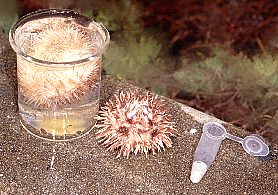

11/19/97

Female & eggs, male, collected sperm
Lytechinus pictus
|
WHEN |
WHAT |
X |
|
One month before |
Check out aquaria and other equipment to make sure everything is in working order, see Adults. Do you have clean beakers, potassium chloride, syringes, adequate microscopes? Order any chemicals you need. |
|
|
One week before |
1) Order at least 10 sea urchins, from species that are in season. Order to arrive at least one day BEFORE class, preferably 2-3 days (urchins do better if they have "rested" after transport). |
|
|
Day before |
1) Check to be sure the sea urchins look healthy. Review the procedure with students. Show them the animations and discuss the timing of the lab. You could present students with a flow chart of events and assign tasks to specific students. If you have an extended lab period you may wish to use the animations again the day of the lab. |
|
|
At least two hours before 1st class |
If you have enough urchins, you can spawn a male and female and start a culture of embryos to have dividing ones for the 1st period. Follow the suggestions for storage just in case you need to use these gametes (if you do not have success during the class itself). |
|
|
One hour before next class |
Start a culture of embryos to have ones dividing for next class |
|
|
During class (summary of lab procedure) |
1) Introduce the topic 2) Demonstrate spawning ONE sea urchin. (you probably do not have the number of urchins or the time to spawn enough animals to get a male and a female every class period). ONLY YOU HANDLE KCl & SYRINGE! 3) Bring out the gametes from storage and demonstrate fertilization under the video microscope. 4) Have students focus on eggs under their microscopes and you go around with a dilute sperm suspension to add to each slide of eggs. 5) Show students where earlier cultures are for them to get a few embryos at various stages to look at and draw. 6) Set aside the class culture started, so students can come in later to observe and draw on subsequent periods and days. 7) DO have students assist in cleanup. This is a VERY necessary skill for the scientist. |
|